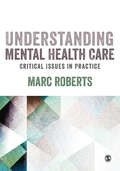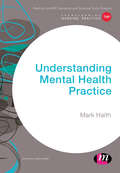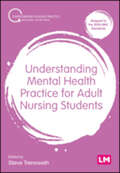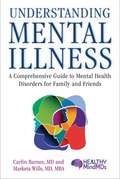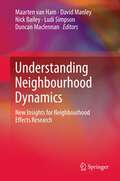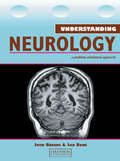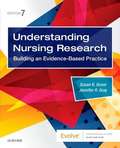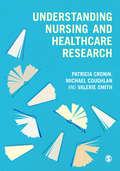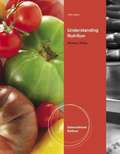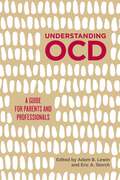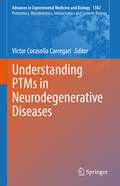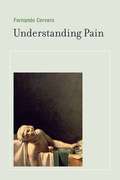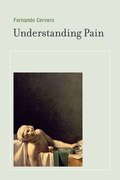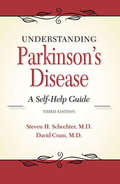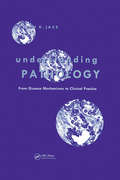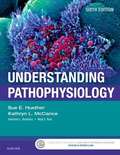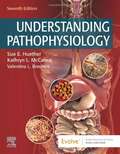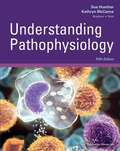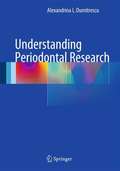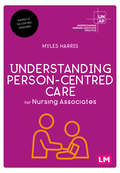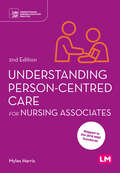- Table View
- List View
Understanding Mental Health Care: Critical Issues In Practice
by Marc RobertsPractitioner-focused, essential reading for students of mental health, this dynamic book provides a critical overview of current issues in mental health practice. It offers concrete guidance on navigating and evaluating different approaches to mental health care, giving crucial space to approaches which put the service user at the heart of care provision and recovery. Tackling the complex and challenging, Understanding Mental Health: Guides students through the landscape of mental health care through detailed case studies that situate practice and bring theory to life Provides a thorough introduction to critical issues through sign-posted chapter aims, concept summaries and activities
Understanding Mental Health Care: Critical Issues In Practice
by Marc RobertsPractitioner-focused, essential reading for students of mental health, this dynamic book provides a critical overview of current issues in mental health practice. It offers concrete guidance on navigating and evaluating different approaches to mental health care, giving crucial space to approaches which put the service user at the heart of care provision and recovery. Tackling the complex and challenging, Understanding Mental Health: Guides students through the landscape of mental health care through detailed case studies that situate practice and bring theory to life Provides a thorough introduction to critical issues through sign-posted chapter aims, concept summaries and activities
Understanding Mental Health Practice (Transforming Nursing Practice Series)
by Mark HaithMental health is a vast and fascinating subject but knowing where to begin can be challenging. This book focuses on the fundamentals of mental health care. It is packed full of ‘need-to-know’ information that will help students understand what is meant by mental health and wellbeing, be aware of the common mental health problems, as well as the typical interventions and treatment options available. The book focuses in on the most essential knowledge providing the ideal starting point for anyone looking to gain an initial understanding of mental health.
Understanding Mental Health Practice for Adult Nursing Students (Transforming Nursing Practice Series)
by Steve TrenowethAs an adult nurse you will come into contact with a wide-range of service users during your practice. Whilst your focus might be on the physical problem that brought them to you, understanding their mental health is also a key part of your role and important to treating people effectively. This book will give you practical guidance on how to respond to the needs of those in your care who face mental health challenges, helping you be more prepared and be able to deliver person-centred care confidently. Key features · Fully mapped to the new NMC standards of proficiency for registered nurses (2018) · Case studies, activities and other learning features help you translate the theory to practice · A practical guide to help you achieve the proficiencies required of you by the NMC
Understanding Mental Health Practice for Adult Nursing Students (Transforming Nursing Practice Series)
by Steve TrenowethAs an adult nurse you will come into contact with a wide-range of service users during your practice. Whilst your focus might be on the physical problem that brought them to you, understanding their mental health is also a key part of your role and important to treating people effectively. This book will give you practical guidance on how to respond to the needs of those in your care who face mental health challenges, helping you be more prepared and be able to deliver person-centred care confidently. Key features · Fully mapped to the new NMC standards of proficiency for registered nurses (2018) · Case studies, activities and other learning features help you translate the theory to practice · A practical guide to help you achieve the proficiencies required of you by the NMC
Understanding Mental Illness: A Comprehensive Guide to Mental Health Disorders for Family and Friends
by Carlin Barnes Marketa WillsGet the straight facts about mental illness from two Harvard trained psychiatrists. More than 40 million people in the US suffer from mental health problems—yet less than half receive adequate care and treatment. Even in the 21st century with the most advanced medical care in the world, social stigma still surrounds psychiatric problems, and this, combined with a lack of understanding, perpetuates a national mental health crisis affecting those in need and their families. Ignoring and/or being unaware of a problem can have devastating effects in our families and for society at large—many people living with mental illness go untreated, and as a result, people with untreated mental illnesses make up one third of the nation’s homeless population and can be imprisoned. To meet these challenges, Dr. Carlin Barnes and Dr. Marketa Wills have written this necessary and comprehensive, practical guide to educate and help everyone better understand mental health. Each chapter offers insights and wisdom concerning a variety of psychiatric conditions, including: Mood disordersAnxiety disordersPersonality disordersSubstance abuse issuesEating disordersWomen’s mental health issuesSuicide in AmericaGeriatric mental healthProfessional athletes and mental healthAnd more Armed with this knowledge, you and your loved one can better appreciate the real struggles at hand, and as a result, seek the proper care needed.
Understanding Neighbourhood Dynamics
by Nick Bailey Duncan Maclennan Ludi Simpson Maarten Van Ham David ManleyThis rare interdisciplinary combination of research into neighbourhood dynamics and effects attempts to unravel the complex relationship between disadvantaged neighbourhoods and the life outcomes of the residents who live therein. It seeks to overcome the notorious difficulties of establishing an empirical causal relationship between living in a disadvantaged area and the poorer health and well-being often found in such places. There remains a widespread belief in neighbourhood effects: that living in a poorer area can adversely affect residents' life chances. These chapters caution that neighbourhood effects cannot be fully understood without a profound understanding of the changes to, and selective mobility into and out of, these areas. Featuring fresh research findings from a number of countries and data sources, including from the UK, Australia, Sweden and the USA, this book offers fresh perspectives on neighbourhood choice and dynamics, as well as new material for social scientists, geographers and policy makers alike. It enriches neighbourhood effects research with insights from the closely related, but currently largely separate, literature on neighbourhood dynamics.
Understanding Neurology: A Problem-Oriented Approach (Medical Understanding Ser.)
by John GreeneThis book takes a problem-oriented approach to the evaluation of common symptoms presenting to medical students. It begins with guidance in history taking and examination leading the student on to neurological examination. The following sections outline all the common presenting symptoms, such as forgetfulness, dizziness or pain, and relate them to
Understanding Neuropsychiatric Disorders: Insights from Neuroimaging
by Martha E. Shenton Bruce I. TuretskyAn informative and comprehensive review from the leading researchers in the field, this book provides a complete one-stop guide to neuroimaging techniques and their application to a wide range of neuropsychiatric disorders. For each disorder or group of disorders, separate chapters review the most up-to-date findings from structural imaging, functional imaging and/or molecular imaging. Each section ends with an overview from a internationally-renowned luminary in the field, addressing the question of 'What do we know and where are we going?' Richly illustrated throughout, each chapter includes a 'summary box', providing readers with explicit take-home messages. This is an essential resource for clinicians, researchers and trainees who want to learn how neuroimaging tools lead to new discoveries about brain and behaviour associations in neuropsychiatric disorders.
Understanding Nursing Research: Building an Evidence Based Practice
by Jennifer Gray Susan GroveEdition after edition, Burns & Grove’s Understanding Nursing Research: Building an Evidence-Based Practice has been known as a leading textbook of nursing research for evidence-based practice (EBP). Now under the authorship of Drs. Grove and Gray, this streamlined and enhanced 7th edition gives you even sharper insights into understanding, appraising, and applying published research for evidence-based nursing practice. Known for its authoritative content, time-tested systematic approach, and unique research example format ― the new edition of this bestselling textbook includes an enhanced EBP focus, new content on the emerging trend of mixed-methods research, and a spotlight on need-to-know information to equip you to apply the latest evidence to your clinical practice.
Understanding Nursing and Healthcare Research: An Introduction For Nurses And Healthcare Practitioners
by Valerie Smith Michael Coughlan Patricia CroninThis book focuses on enabling students to understand what research is, why it is relevant in healthcare and how it should be applied in practice. It takes the reader step by step through the research process, from choosing research questions through to searching the literature, analysing findings and presenting the final piece of work. Key features of the book are: Tips for the best practice when reading and critiquing research. Activities to test your knowledge. Key points which highlight the important topics. A companion website which includes a critical appraisal tool to use when assessing papers, multiple choice questions and free SAGE journal articles for students. Seminar plans and PowerPoint slides are provided to support lecturers in their teaching. It is essential reading for all undergraduate students of nursing, midwifery and healthcare.
Understanding Nutrition (Thirteenth Edition)
by Eleanor Noss Whitney Sharon Rady RolfesThis best-selling introductory nutrition text is praised for its approachable narrative, engaging presentation, and careful explanations. The new Thirteenth Edition of Whitney and Rolfes' UNDERSTANDING NUTRITION takes the study of nutrition to a new level with an integrated pedagogy and an emphasis on active learning, assignable content, and integrated resources. From its beautiful and carefully developed art program to its strong science base, contemporary coverage, and market-leading supplements, the Thirteenth Edition of UNDERSTANDING NUTRITION connects with its readers and continues to set the standard for texts in this market. This text includes 20 chapters beginning with core nutrition topics, such as diet planning, macronutrients, vitamins and minerals, and following with chapters on diet and health, fitness, life span nutrition, food safety, and world hunger. UNDERSTANDING NUTRITION connects with students--engaging them as it teaches the basic concepts and applications of nutrition.
Understanding OCD: A Guide for Parents and Professionals
by Dean Mckay Eric A. Storch Adam B. Lewin Jennifer Park Brittany Rudy Caleb Lack Carly Johnco Gary Geffken Joseph Mcguire Joseph Mcnamara Lisa Bateman Marni Jacob Michael Sulkowski Robert SellesGiving a full overview of childhood obsessive compulsive disorder (OCD) and discussing all major treatment options, including cognitive behavioural therapy and medication, this guide provides the essential information that families, teachers, caregivers, clinicians and mental health professionals need in order to understand and treat childhood OCD. It covers origins, symptoms and related illnesses and explains how OCD is diagnosed. The book also suggests ways to maximise the outcomes of treatment, what to do when treatment doesn't work, and how to help manage OCD in children at school and in the home.
Understanding PTMs in Neurodegenerative Diseases (Advances in Experimental Medicine and Biology #1382)
by Victor Corasolla CarregariThis new volume, a part of the Proteomics, Metabolomics, Interactomics and Systems Biology series, will explain how proteomic studies of post-translational modifications (PTMs) can be applied to neurodegenerative diseases and relevant studies. The goal of the book is to increase awareness among researchers about how PTMs may be helpful in understanding mechanisms in various neurodegenerative diseases through proteomic studies. This book will serve as a tool for those who want to begin work in the proteomics field and explore how to implement PTMs studies into their work. Chapter authors will describe different PTMs enrichment methods developed by experts in the field so that researchers may learn to apply these methods and techniques to new studies. Divided into three sections, chapters will cover sample preparation, data quality, enrichment techniques, guidelines on how to analyze PTMs, and explain the role of PTMs and different brain diseases. Among those topics includes will be brain cancer, SLA disease, Parkinsons disease, muscular dystrophies, and schizophrenia. This volume will be useful for researchers and students studying brain and neurodegenerative diseases who are interested in delving into work with proteomic studies and PTMs.
Understanding Pain
by Fernando CerveroIf you touch something hot, it hurts. You snatch your hand away from the hot thing immediately. Obviously. But what is really happening, biologically--and emotionally? In Understanding Pain, Fernando Cervero explores the mechanisms and the meaning of pain. You touch something hot and your brain triggers a reflex action that causes you to withdraw your hand, protecting you from injury. That kind of pain, Cervero explains, is actually good for us; it acts as an alarm that warns us of danger and keeps us away from harm. But, Cervero tells us, not all pain is good for you. There is another kind of pain that is more like a curse: chronic pain that is not related to injury. This is the kind of pain that fills pain clinics and makes life miserable. Cervero describes current research into the mysteries of chronic pain and efforts to develop more effective treatments. Cervero reminds us that pain is the most common reason for people to seek medical attention, but that it remains a biological enigma. It is protective, but not always. Its effects are not only sensory but also emotional. There is no way to measure it objectively, no test that comes back positive for pain; the only way a medical professional can gauge pain is by listening to the patient's description of it. The idea of pain as a test of character or a punishment to be borne is changing; prevention and treatment of pain are increasingly important to researchers, clinicians, and patients. Cervero's account brings us closer to understanding the meaning of pain.
Understanding Pain: Exploring the Perception of Pain
by Fernando CerveroAn expert explores the nature of pain: why it hurts and why some pain is good and some pain is bad.If you touch something hot, it hurts. You snatch your hand away from the hot thing immediately. Obviously. But what is really happening, biologically—and emotionally? In Understanding Pain, Fernando Cervero explores the mechanisms and the meaning of pain. You touch something hot and your brain triggers a reflex action that causes you to withdraw your hand, protecting you from injury. That kind of pain, Cervero explains, is actually good for us; it acts as an alarm that warns us of danger and keeps us away from harm. But, Cervero tells us, not all pain is good for you. There is another kind of pain that is more like a curse: chronic pain that is not related to injury. This is the kind of pain that fills pain clinics and makes life miserable. Cervero describes current research into the mysteries of chronic pain and efforts to develop more effective treatments. Cervero reminds us that pain is the most common reason for people to seek medical attention, but that it remains a biological enigma. It is protective, but not always. Its effects are not only sensory but also emotional. There is no way to measure it objectively, no test that comes back positive for pain; the only way a medical professional can gauge pain is by listening to the patient's description of it. The idea of pain as a test of character or a punishment to be borne is changing; prevention and treatment of pain are increasingly important to researchers, clinicians, and patients. Cervero's account brings us closer to understanding the meaning of pain.
Understanding Parkinson's Disease: A Self-Help Guide
by David L Cram Steven H SchechterIf you've been told by your doctor, "You have Parkinson's disease," you probably found it difficult to hear those words. Such a diagnosis can be frightening and leave you filled with questions. How will it affect your life? What are your treatment options? These authors are uniquely qualified to understand your concerns. Steven Schechter, M.D., is a neurologist who has treated thousands of patients with Parkinson's disease, and David Cram, M.D., lived with the disease himself. Among the topics they cover are: diagnosis, symptoms and stages, the emotional side of PD—conquering fear and denial, choosing the right health care team, drug therapy—medications and how they work, surgical options, deep brain stimulation, the importance of exercise, coping with day-to-day problems, and care for caregivers.
Understanding Pathology: From Disease Mechanism To Clinical Practice
by Jeremy JassThis book shows how the discipline of pathology fits into society and interfaces with science and medicine. It focuses on anatomical pathology and covers the practice of laboratory medicine in the clinical setting. The book is helpful for health professionals, especially anatomical pathologist.
Understanding Pathophysiology
by Sue E. Huether Kathryn L. McCanceMaster the important pathophysiology concepts you need to know with the most engaging and reader-friendly text available. Filled with vibrant illustrations and complemented by online resources that bring pathophysiology concepts to life, Understanding Pathophysiology, 6th Edition continues its tradition of delivering the most accurate information on treatments, manifestations, and mechanisms of disease across the lifespan, giving you the fundamental knowledge needed to move forward in your nursing education and career. New additions include a new chapter on epigenetics, new content on rare diseases, a separate chapter for male and female reproductive alterations, streamlined features, simplified language, and fully updated information throughout.
Understanding Pathophysiology
by Sue E. Huether Kathryn L. McCanceMake difficult pathophysiology concepts come to life! Filled with vibrant illustrations, simplified language, and detailed online content Understanding Pathophysiology, 7th Edition delivers the most accurate information on treatments, manifestations, and mechanisms of disease across the lifespan. <p><p>This new edition is fully revised and includes coverage of rare diseases and epigenetics to you with a thorough understanding of conditions affecting the human body. Plus, with over 30 new 3D animations on the companion Evolve site, quick check boxes at the end of each chapter, and disease progression algorithms, this text helps you engage with the fundamental knowledge you need to succeed in nursing school and in practice.
Understanding Pathophysiology
by Kathryn L. Mccance Sue E. HuetherLearn the essential concepts of pathophysiology and stay up to date on treatments, manifestations, and mechanisms of disease with Understanding Pathophysiology, 5th Edition. Filled with vibrant illustrations and complemented by online resources that bring pathophysiology concepts to life, this easy-to-read text delivers the latest, most accurate information on the disease process across the lifespan, giving you the fundamental knowledge you need to move forward in your nursing education. Consistent presentation helps you better distinguish pathophysiology, clinical manifestations, and evaluation and treatment for each disease. More than 1,000 high-quality illustrations vividly depict clinical manifestations and cellular mechanisms underlying diseases. Lifespan coverage details age-specific conditions affecting pediatric, adult, and aging patients in great depth. Algorithms throughout the text clarify disease progression. "Risk Factor "boxes alert you to important safety considerations associated with specific diseases. "Health Alert" boxes highlight new developments in biologic research, diagnostic studies, preventive care, treatments, and more. "Quick Check "boxes test your retention of important chapter concepts. "Did You Understand?" sections provide fast, efficient review of chapter content. Chapter outlines help you find specific information with ease. Chapter introductions explain why chapter content is important and how it fits into a broader health care context. Key terms are bolded throughout the text for fast, easy reference. Glossary of selected terms familiarizes you with the most difficult or important terminology. Companion Evolve website provides convenient online access to animations, review questions, key terms matching exercises, and more. NEW! Extensively updated content reflects the latest clinical findings and research across the full spectrum of pathophysiology. NEW! Hundreds of new and enhanced full-color illustrations clarify anatomy and physiologic concepts. NEW! 30 new animations on the companion Evolve website reinforce your understanding of complex processes.
Understanding Periodontal Research
by Alexandrina L DumitrescuAs stated by The Cochrane Collaboration on their website, the practice of evidence-based medicine means integrating individual clinical expertise with the best available external clinical evidence from systematic research. Understanding Periodontal Research fills a significant gap in the literature by providing oral health and periodontal researchers with a comprehensive overview of the methodological aspects that are important when planning, conducting, and analyzing their research projects. It is designed to be easy to understand for beginners in the field, yet will also serve as a useful tool for those who are more experienced. Undergraduate and postgraduate dental students, dental hygienists, dental practitioners, and associated professionals who are interested in understanding the principles of periodontal research will all benefit from the clear information and guidance contained in this book.
Understanding Person-Centred Care for Nursing Associates (Understanding Nursing Associate Practice)
by Myles HarrisUnderstanding how to deliver effective, person-centred care is vital for a future career as a Nursing Associate. In this book, trainee nursing associates are introduced to the principles of person-centred care, with case studies from a variety of healthcare settings and guidance on caring for different patient groups, from acute care to long-term and palliative care. This allows TNAs to see how the theory can be directly applied to their daily practice, regardless of where they work. The book also covers key issues in relation to providing care, such as inclusivity, ethics, legal issues, and health inequalities. Key features: Fully mapped to the new NMC standards of proficiency for nursing associates (2018) Case studies, activities and other learning features help TNAs understand the theory and apply it to practice Designed around a Nursing Associate course, this book demonstrates how person-centred care feeds into each core module. ABOUT THE SERIES: The Understanding Nursing Associate Practice series (UNAP) is a new collection of books uniquely designed to support trainee Nursing Associates throughout their training and into a professional career.
Understanding Person-Centred Care for Nursing Associates (Understanding Nursing Associate Practice)
by Myles HarrisUnderstanding how to deliver effective, person-centred care is vital for a future career as a Nursing Associate. In this book, trainee nursing associates are introduced to the principles of person-centred care, with case studies from a variety of healthcare settings and guidance on caring for different patient groups, from acute care to long-term and palliative care. This allows TNAs to see how the theory can be directly applied to their daily practice, regardless of where they work. The book also covers key issues in relation to providing care, such as inclusivity, ethics, legal issues, and health inequalities. Key features: Fully mapped to the new NMC standards of proficiency for nursing associates (2018) Case studies, activities and other learning features help TNAs understand the theory and apply it to practice Designed around a Nursing Associate course, this book demonstrates how person-centred care feeds into each core module. ABOUT THE SERIES: The Understanding Nursing Associate Practice series (UNAP) is a new collection of books uniquely designed to support trainee Nursing Associates throughout their training and into a professional career.
Understanding Person-Centred Care for Nursing Associates (Understanding Nursing Associate Practice)
by Myles HarrisUnderstanding how to deliver effective, person-centred care is vital for a future career as a Nursing Associate. In this second edition, trainee nursing associates will be introduced to the principles of person-centred care, provided with guidance on caring for a broad range of different patient groups (including acute, long-term and palliative care), and prepared for practice in any healthcare setting via case studies drawn from across the lifespan and nursing fields. Key issues relating to providing care such as inclusivity, health inequalities and ethics are covered, including through new case studies. Key features: Clearly explains the principles and theory underpinning person-centred care to encourage a holistic and evidence-based approach to practice Fully mapped to the NMC standards of proficiency for nursing associates (2018) Case studies and activities drawn from all fields of nursing and across the lifespan illustrate theory in different practice settings Written specifically to address the unique experiences, challenges and requirements of the nursing associate role ABOUT THE SERIES: The Understanding Nursing Associate Practice series (UNAP) is a new collection of books uniquely designed to support trainee nursing associates throughout their training and into a professional career.
